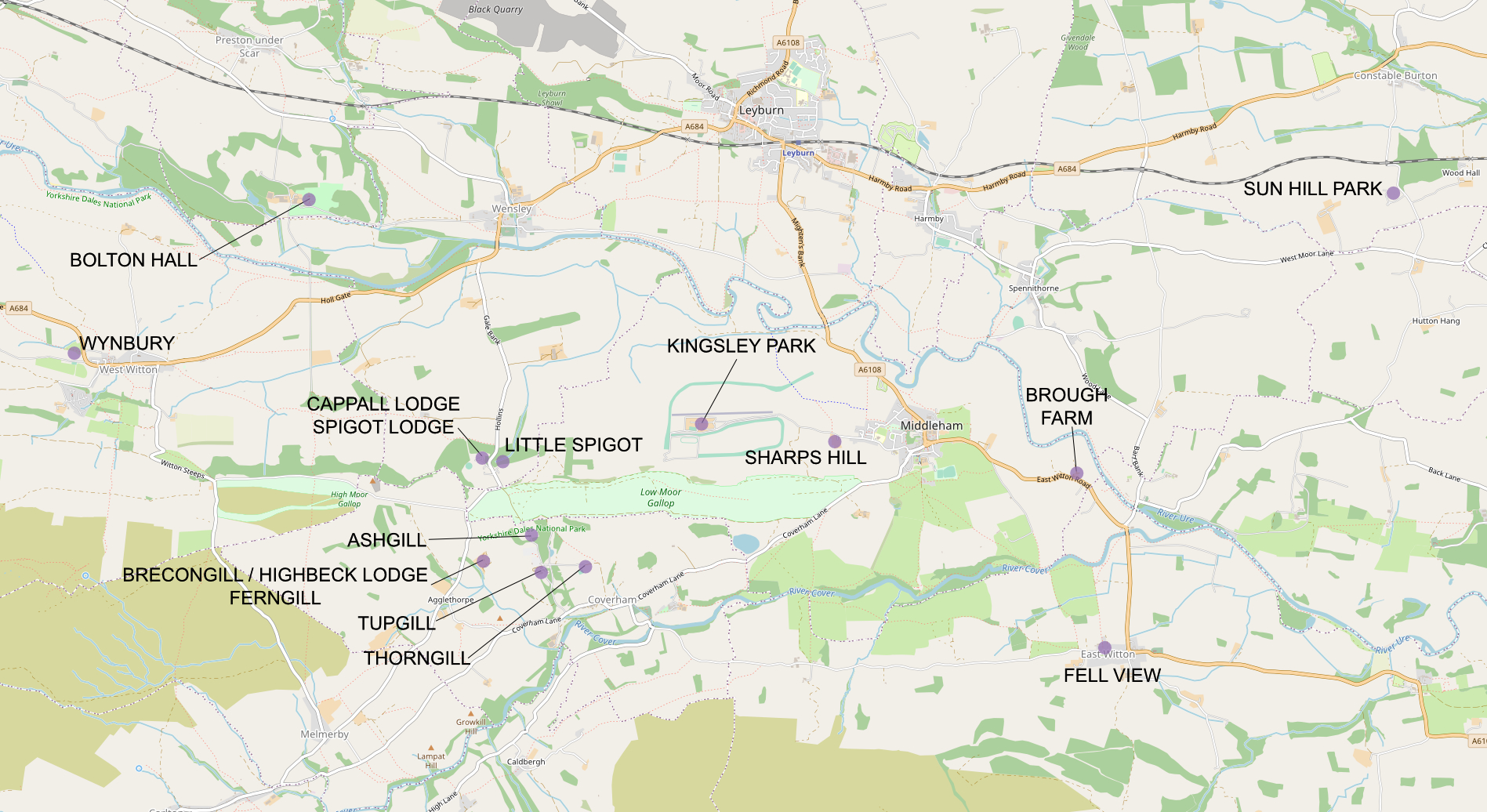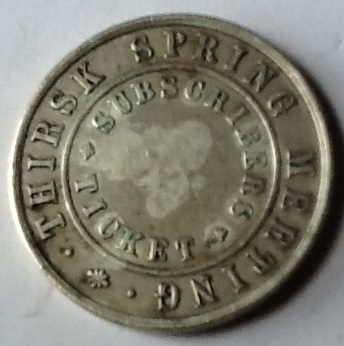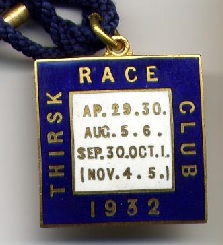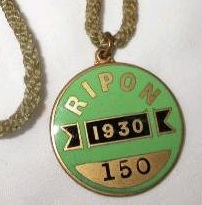In addition to the 30 or so recognised Stables in Middleham that have operated throughout the past 250 years, there are some whose loactions were unknown but were referred to as Middeham Moor Stables. Some of these may well have been located at present day stables, whilst others were used by one trainer after another, notably Thomas Winter and John Drislane, and until their exact locations are known they have been amalgamated in this section.
Today Ed and James Bethell are in charge of Thorngill on the Tupgill Estate, but back in the 1780s another Bethell, not necessarily a relation and not necessarily in the exact same location, William Bethell and his trainer Christopher Jackson sent out Ruler (SR 1859) to win the 1780 St Leger at Doncaster. The newspapers of the day described Jackson's stables as 'Middleham and Langton Wold' which are some considerable distance apart, so it is not known whether he trained Ruler at Middleham and, if so, exactly where. However, given that John Mangle, based in Middleham, rode the horse, it is more likely that he was trained at Middleham than Langton Wold. He has been included in the this general section on Middleham Moor Stables until further clarification is available to show exactly where he trained. Two years later Christopher Jackson won the 1782 St Leger with Imperatrix (SR 1747), this time for the Reverend Henry Goodricke and John Pratt, and it was still suggested that he was training at Middleham and Langton Wold, but George Searle was also Middleham based, so Middleham seems to be favourite. During his time in Middleham he was closely associated with the Collinson brothers, Francis and William; Frank was an accomplished jockey riding Pan to win the 1808 Epsom Derby, and both brothers trained in Middleham.
1780 St Leger at Doncaster RULER (SR 1859) 5/2 owned by William Bethell, trained by Christopher Jackson and ridden by John Mangle
1782 St Leger at Doncaster IMPERATRIX (SR 1747) owned by Reverend Henry Goodricke and John Pratt, trained by Christopher Jackson and ridden by George Searle.
1841-1850 Richard Drewitt
Richard Drewitt, born in 1815, had a long training career, as he was listed in the 1841 Census as a trainer in the West End area of the Town of Middleham, remaining there for 9 years, and then relocated to Lewes where he spent the remainder of his training career. He was supported by William Manser, who spent time with Drewitt before becoming a vet for 2 years, and then began training in Egypt and Russia, but was later training in Newmarket. Another who spent time with Drewitt as his Head Lad was William Greaves, who then worked for George and William Oates in Kirkgate, Middleham before also training in his own right in Newmarket. Richard Drewitt died in 1874.
1842 Ralph Warrior
In February 1842 Ralph Warrior was training at Middleham, although he appears to have had just a single horse, a sister to Pathfinder.
1842 J Musgrave
In February 1842 Musgrove was training at Middleham, although he appears to have had just one horse in his small string, a bay colt by Memnon.
1842-December 1845 William Lumley
William Henry Fortesque Claren Lumley, born 1791, was living at the Spread Eagle in Epsom, having previously resided at the Kings Head in Epsom. He was trainer to General Wyndham in the early 1840s, but by 1842 he had moved to West End, Middleham as private trainer to the Yorkshire owner Colonel Sheldon Cradock, training Infidel to run third in the Dee Stakes at Chester in 1844, and Jinglepot to win the 1845 Wright Stakes at Richmond, having aimed too high when unplaced in the Mersey Stakes at Liverpool and the Champagne Stakes at Doncaster. Lumley's training affairs were complicated because he seemed to operate from a number of different yards, second yards and satellite yards at the same time. He was in Middleham throughout 1843 to 1844, but in late 1845 he trained a small string for Lord George Bentinck in Newmarket, before moving to College House, Lambourn in 1846 as private trainer to J S Drinkald. By the end of the 1847 season, having trained Drinkald a Chester Cup (Tradesmans Plate) winner St Lawrence, he returned to Epsom where he continued his training career. In the final days of his time in Middleham, despite having moved to Newmarket, he returned to the Yorkshire racing town to oversee the sale of Colonel Cradock's racing yard in December 1845. He lived to a ripe old age, dying in May 1878 aged 87.
1847 Chester Cup (Tradesmans Plate) ST LAWRENCE 25/1 owned by J S Drinkald, trained by William Lumley and ridden by William Ford
1846-1847 William Dilly
William Dilly, youngest son of Montgomery Dilly and his wife Ann, was brother to John, the eldest son, and Montgomery junior who all carved out racing careers. John trained in Newmarket and bought Priam as a yearling before selling him to the Chifneys. Montgomery and William began training at Littleton. In 1845 William was in the running to be appointed private trainer to the Duke of Bedford, but missed out when William Butler was appointed instead. In 1846 William Dilly moved to the West End area of Middleham where he remained for just 2 years. He departed Middleham in 1847 and died in 1880.
1851 Thomas Walter
Thomas Walter, born in Uttoxeter, Staffs, married Ann Ibbotson, daughter of the landlord of the Black Swan Inn, on Monday 21st April 1851, and was a trainer in stables just off the Market Place in 1851, with Mark Noble as his jockey and Head Lad. He had two horses, Mary Nobbler and Maid of the Team Valley, but neither enjoyed much success. Therefore, it was not financially viable and the couple transferred to stables at Radcliffe in Lancashire in early 1852. Tragically, on Sunday 22nd August 1852 Thomas was found drowned in the River Irwell on the outskirts of Radcliffe, and a later coroners verdict was death at a period of temporary insanity.
William Weatherall, often written as Wetherell, born in 1803, assisted Hambleton trainer Robert Hesseltine prior to training on his own account at Delamere Forest between 1844 and 1848. He then moved to the famous Mostyn Stables at Holywell, on the doorstep of Holywell Racecourse where he was Clerk of the Course. By 1854 he had moved north to Middleham, training Lance to win the 1856 Portland Handicap at Doncaster for Mr Hind when ridden by Wilberforce. The preparation for Lance was curious because he finished a creditable second in a competitive Handicap at the Beverley and Hull meeting in June, but then in August it won the Copeland Handicap at Stoke Wake races in August. Would the Jockey Club allow such a preparation today? After his time in Middleham he sailed across the Irish Sea in 1858 to train at Curraghmore for Lord Waterford, replacing Richard Prince. This period of his career was short-lived as the good Lord was killed in a hunting accident in 1859 leaving Weatherall to seek an alternative training post. By 1864 Weatherall had moved to Parrs House, Upper Lambourn which had stabling for 24 horses, but he could only get 8 horses, which reduced to 4 the following year.

However, in 1866 he tried for an alternative source of income by advertising the Ashdown Coursing meeting at Upper Lambourn, offering accommodation for those wishing to attend. He had some success in Ireland and whilst at Lambourn training the likes of Lancashire Witch, Sharston, Young England, Truth and Lance. By 1868, with his string down to an unviable number, he moved to East Ilsley, but once again his period in the village was curtailed and he transferred back north to Richmond as a public trainer in 1870. He had quiet years in Richmond, but ever the journeyman trainer, he relocated to Beverley and died there on 21st January 1881 at the age of 77.
1856 Portland Handicap at Doncaster LANCE 11/1 owned by Mr J A Hind, trained by William Weatherall and ridden by Wilberforce.
George Oates, born in 1830, younger son of 'old' George Oates, who had trained for a prolonged period at Ashgill, Middleham, and brother of William Oates, was one of the most respected trainers of his day, training Butterfly (SR 1827), alongside brother William, to win the 1860 Epsom Oaks and a year later saddling Kettledrum (SR 2048) to win the 1861 Epsom Derby. The Oates brothers had trained jointly in Kirkgate, Middleham for a number of years before enjoying their success with Butterfly, but sadly, on 7th August 1861 William died after suffering from a terminal illness, almost certainly bowel cancer as he struggled to be regular with his bowels towards the end, and was buried in Middleham churchyard. William, who was aged 42 and unmarried, had enjoyed coursing, winning many cups in the sport. He had been responsible for training Sir Tatton Sykes (SR 1990) at Highfield House, Malton for William Scott when the horse won the 1846 2000 Guineas and St Leger, but was beaten a neck by Pyrrhus The First (SR 1951) in the Epsom Derby. George continued to train in Middleham for the next 9 months, and then leased his stables to Lord Glasgow who needed extra boxes for his trainer Tom Dawson. For many years George had been based both at Richmond and Middleham, training for Colonel Towneley, although in 1863 Towneley transferred all of his horses to John Scott, leaving Oates to become a public trainer, but by then Oates had already moved to Seven Barrows Stables in Lambourn. Up until May 1862 George Oates trained in Middleham, although he did venture south to the Stork House stables of John Prince in Lambourn when he prepared Kettledrum for a tilt at the 1861 Epsom Derby, which the horse went on to win. Towneley and Oates were pioneers, trying out new training ideas, one of which established a Turkish Bath for horses at Seven Barrows in January 1863. The entire process was supervised by their vet Mr Moore and involved introducing hot air through grating over which the racehorse was placed, and an experienced stablehand used friction to 'foster profuse perspiration.' A large syringe of icy cold water was then squirted over the horse before it was scraped and rubbed dry, after which it walked to its box with 'renewed vigour.' As early as April 1863 Towneley announced that all of his horses would leave Seven Barrows bound for John Scott, leaving Oates to become a public trainer. Oates was well respected and shortly after the announcement Mr W Robinson, amongst others, sent his horses to Seven Barrows. Oates continued to train at Seven Barrows until 1866, when he moved his training enterprise north again. He arrived back in Middleham in September 1867, taking back his house and stables on the High Moor where he had sufficient room for 16 horses, and commenced training there immediately. He remained in Middleham until 1872, thereafter training at French Gate, Richmond. Towards the end of his life Oates trained for Mr Vyner at Fairfield, but George died on Saturday 25th January 1890 aged 59.
1846 2000 Guineas at Newmarket SIR TATTON SYKES (SR 1990) 5/1 owned and ridden by Bill Scott and trained by William Oates
1846 St Leger at Doncaster SIR TATTON SYKES (SR 1990) 3/1 owned and ridden by Bill Scott and trained by William Oates
1846 Epsom Derby SIR TATTON SYKES (SR 1990) 16/1 owned and ridden by Bill Scott and trained by William Oates, second beaten a neck by Pyrrhus the first 8/1 (SR 1951)

John Hampton Winter, later taking the name Thomas Hampton Winter, was born in 1838 and spent the early part of his working life with John Scott before he joined William L'Anson at his Spring Cottage stables in Malton. He was fortunate to be associated with Blink Bonny in 1857 and Blair Athol in 1861, but his first love was Caller Ou. Caller Ou, which means fresh oysters, was bred at Spring Cottage, Yorkshire in 1858 by William L'Anson, and Thomas was with her throughout her 6 years on the racecourse during which she raced 98 times, winning 49 of them. Her most prestigious victory was in the 1861 St Leger where she defeated Derby winner Kettledrum. In September 1865 Thomas married William L'Anson's second daughter Alice at Norton Church and the couple were blessed with a son and two daughters. Within a month Thomas had launched his own training career at Middleham, his stables were barely a quarter of a mile from Middleham Moor gallops where, in the early years, he trained Carnizette, Ladylike, Apollo's Temple and Esmerelda. His principal owner was Billy Nicholl, but he was also a public trainer, recording his highest profile success with Inveresk in the 1872 Chester Cup for Nicholls by a neck, but had to survive an objection from the second Soucar. In January 1877 he sold his stables to the Irishman, John Drislane, and moved to Lambourn, but by 1878 he had returned to Middleham and, in the 1881 Census he was living at The Hall, which was number 37 in the Middleham Census. He died in Middleham on Saturday 23rd March 1912 aged 74 and left behind his widow Alice and their 3 children.
1872 Chester Cup INVERESK 100/8 owned by Billy Nicholls, trained by Thomas Hampton Winter and ridden by Griffiths
January 1877-February 1891 John Drislane
John Drislane, born in 1826 and universally known as Paddy, enjoyed all country sports, especially hunting and coursing. In November 1865 he was appointed trainer of Joseph Saxon's horses at Saxon House Stables, training horses like Stilton, Beeswing, by Newminster out of The Sphynix, Monitress and Lord Craven, enjoying success with each of them, including the Princess of Wales Plate at Oxford with Beeswing. He also continued to enjoy coursing, especially at Richmond where he had many friends, and ones which he could call on in times of trouble to offer him alternative employment. The next year Saxon and Drislane's fortune turned, the pair sending out John Halifax, Monitress, General Sherman, Patrician and Honey 45 times, but winning only one race, a lowly Railway Stakes at Stockbridge with General Sherman. The relationship must have become strained, particularly when Saxon had to sell Monitress and Patrician, only for them to win 3 races between them after being sold. In autumn 1867 John Drislane was assaulted by Andrew Saxon, stable owner Joseph Saxon's son, who struck him about the head with a pitchfork and led Drislane to take Andrew to court. Andrew was found guilty of the crime and sentenced to two months imprisonment without hard labour. That situation caused a further break in the working relationship between Drislane and Saxon, with Drislane leaving Saxon House on 1st October 1867, taking up the post of Head Lad at Stork House, where Fred Bates trained, before transferring with Bates to Middleham, close to Richmond in 1873. In January 1868 Saxon faced a charge of non-payment of wages at Reading Petty Sessions after he failed to pay Drislane the £15 due in unpaid wages. Saxon lost the case and had to pay Drislane the £15 and costs to the court. Drislane went on to successfully carve out a training career of his own in Middleham, replacing Thomas Hampton Winter at his stables which Drislane purchased at auction for £555, operating as a public trainer. His stable had expanded to 14 horses in 1883 and increased to 16 in 1884. He was a successful trainer, sending out 4 Great St Wilfrid winners at Ripon between 1883 and 1890, and enjoyed particular triumphs with Lady Rosebery in 1888, landing the Great St Wilfrid, Chatsworth Stakes, Thirsk Autumn Cup and Liverpool Autumn Cup. He also scored numerous wins with Miss Ethel, Warlaby, Jane Shore and Black Pearl. He died on 7th February 1891 after accidentally being hit by a horse during a schooling trial, and straight after his death the majority of his string were moved to Tom Green of Hambleton. A couple of months later his former stables were put up for sale by auction, being advertised as, 'A dwelling house and training stables consisting of 11 boxes, situated within a quarter of a mile of the celebrated training ground of Middleham Moor and within 2 miles of Leyburn Station'. It remained unsold after bidding only reached £360.
1888 Great St Wilfrid at Ripon LADY ROSEBERY 2/1 owned by Mr W Winn, trained by John Drislane and ridden by William Wood
1888 Chatsworth Stakes at Derby LADY ROSEBERY 9/2 owned by Mr W Winn, trained by John Drislane and ridden by William Wood
1888 Thirsk Autumn Cup LADY ROSEBERY 100/30 jt fav owned by Mr W Winn, trained by John Drislane and ridden by William Wood
1888 Liverpool Autumn Cup LADY ROSEBERY 100/8 owned by Mr W Winn, trained by John Drislane and ridden by William Wood



1892-1897 George Graham
In December 1892 George Graham took charge of the stables formerly owned by John Drislane, and before him, Thomas Hampton Winter, but whether he bought the stables or leased them is uncertain. It is clear that the stables were advertised for sale in April 1891 but remained unsold after a low bid was rejected. His most promising filly in 1893 was Lively Duchess, while in December 1894 he won the Hedon Handicap Hurdle at Hull with Little Florence. He trained on both Flat and over Jumps, winning the September 1895 Buchanan Handicap at Ayr with Dowie Den. In 1896 his best colts were Ivy Boy and Sureshot, and he continued to train at the same base until 1897.
1894 Hedon Handicap Hurdle at Hull LITTLE FLORENCE 5/2 fav owned by Mr McCloskey, trained by George Graham and ridden by F Black
1895 Buchanan Hurdle at Ayr DOWDIE DEN 6/1 owned by Mr Lapid, trained by George Graham and ridden by Lofthouse
1920-1921 Herbert Smith
Herbert Smith, born in Yorkshire, was the brother of Major S Smith, and the pair both forged careers as racehorse trainers. In 1920 Herbert moved to Middleham to train a small string of 4 horses which increased to 5 with the arrival of Blue Dale in December 1920. In 1921 his licence to train under Rule 102 of the Rules of Racing was extended and a memorable day for the 2 brothers occurred on Monday 1st August 1921 when both landed their first winner of the season at Ripon, Major S Smith, of Doncaster, with Prince Lionel, and Herbert with Valerian. At the end of the 1921 season Herbert left Middleham.
Yorkshire Selling Welter Handicap at Ripon PRINCE LIONEL (10/1) owned and trained by Major S Smith, and ridden by T L Brown
Sharow All-Aged Selling Plate at Ripon VALERIAN (5/2 fav) owned by Mr H Tait, trained by Herbert Smith, and ridden by J Clark
Vyner Handicap at Doncaster CORIOPSIS (100/8) owned by Mrs S Smith, trained by Herbert Smith, and ridden by L Brown



